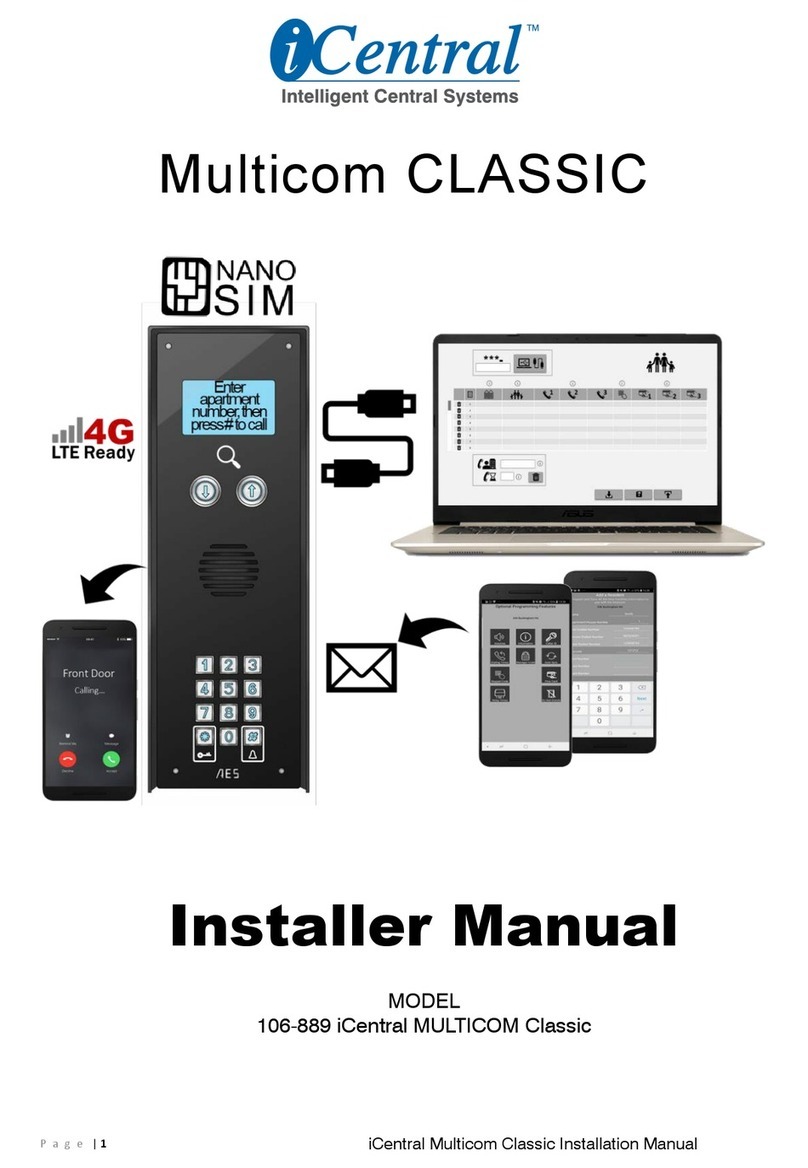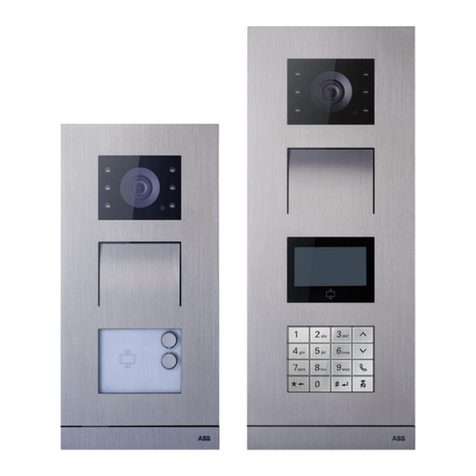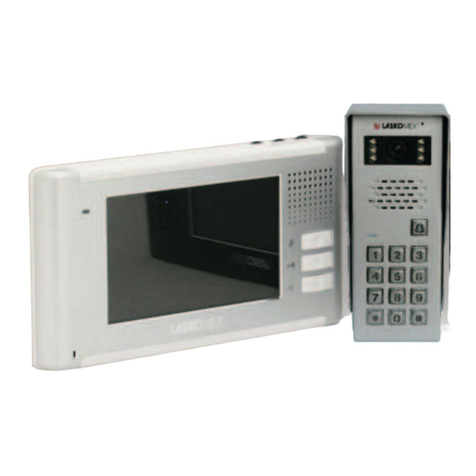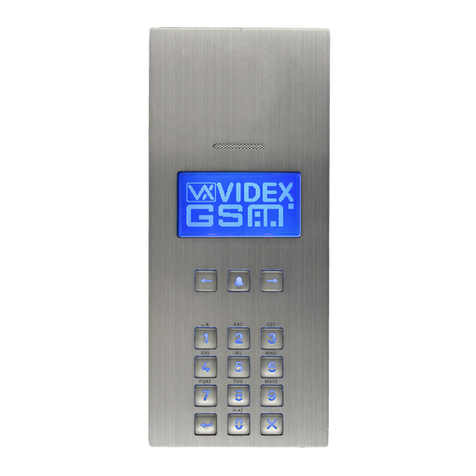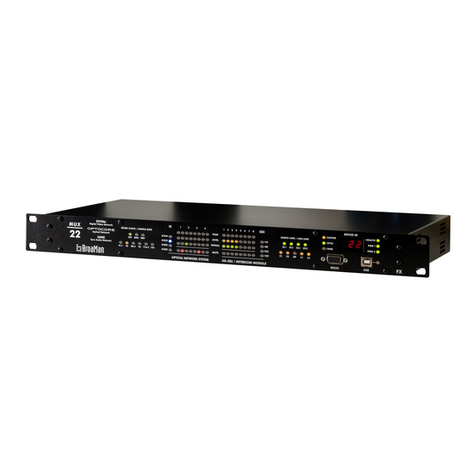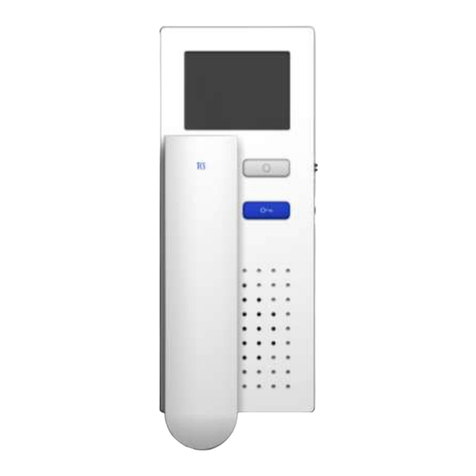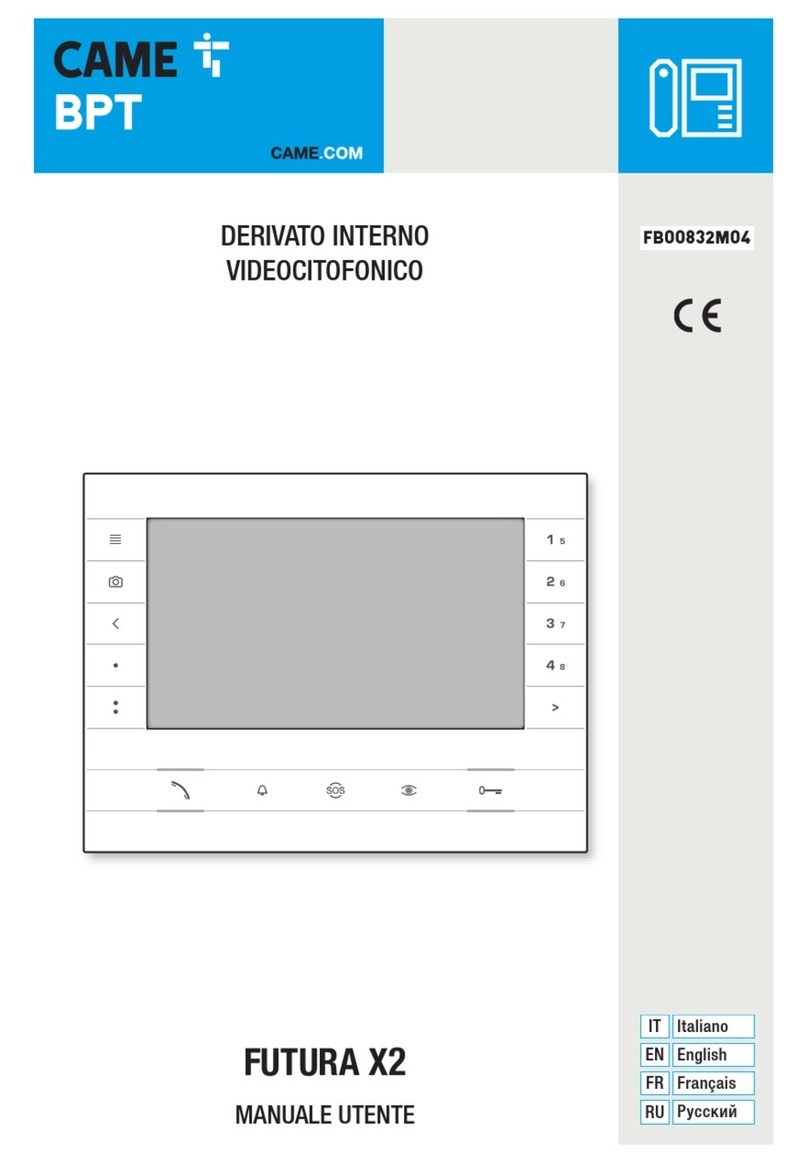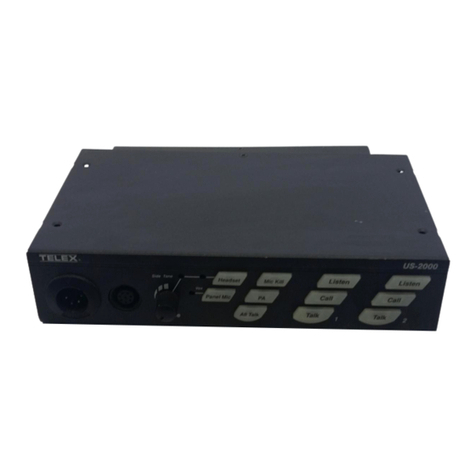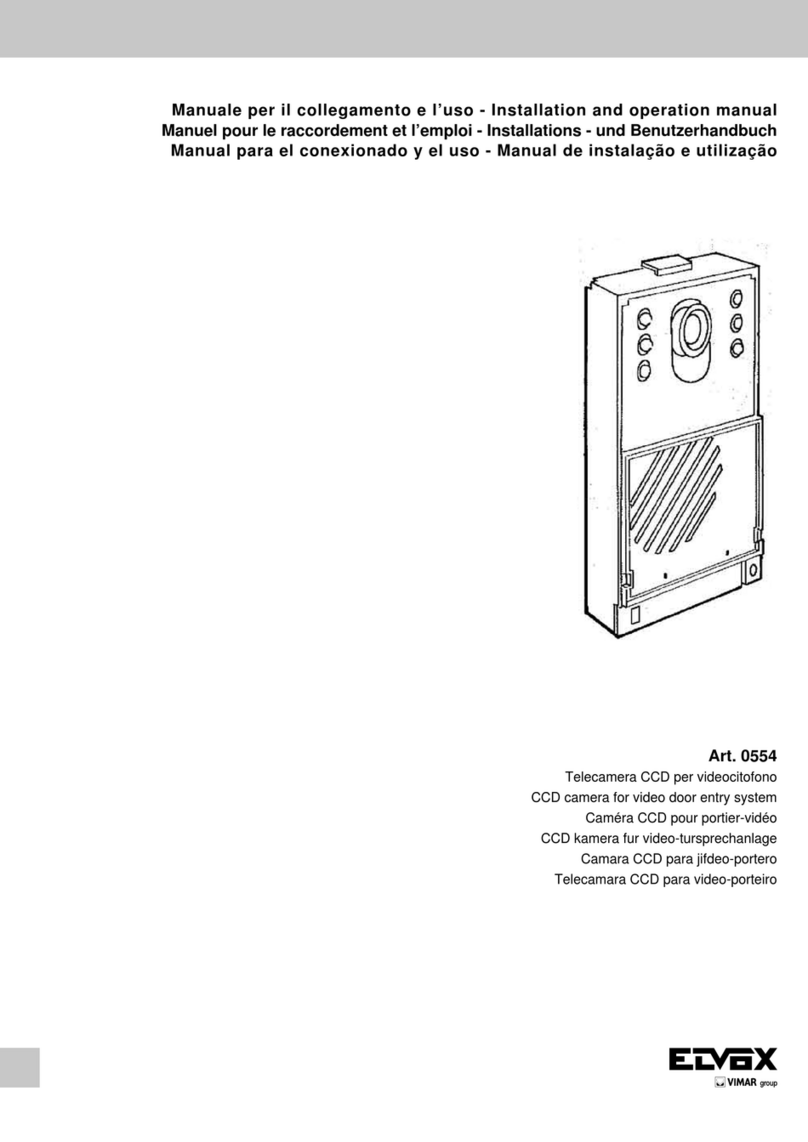FHF Intelly Com User manual

Weatherproof Intercom Station
FHF BA 5228 07/14
Operating manual

2 / 18
Operating Manual - IntellyCom
Notes
Please read the operating manual carefully before installing the device.
Texts and illustrations have been compiled and software created with the utmost care,
however errors cannot be completely ruled out. This documentation is therefore supplied
under exclusion of any liability or warranty of suitability for specific purposes. FHF
reserves the right to improve or modify this documentation without prior notice.
Before opening or dismounting the device it has to be separated from
all voltage supply.
General Description
The IntellyCom is a weatherproof Intercom Station which can be operated in the
analogue, public telephone network or can be connected to analogue terminals of branch
exchanges.
The IntellyCom is available in different designs:
•With casing it is made for wall mounting or it can be fixed on pylons and joists.
•Without casing it is meant as built-in unit.
This manual describes below the construction with casing. The connection of the built-in
unit is made correspondingly, but without considering the cable entries.
The Intercom Station comprises
- a loudspeaker and
- a microphone for voice communication
- a hookswitch key as operating element
- and a LED (part of the hookswitch key)as loop current indicating element.
Utilization and programming is identical in all devices.
Features
- Pulse / tone dialing
- Automativ cleardown capability
- Automatic answering capability or answering after a programmable number of
rings
- Chained numbers if the the called number is busy or does not answer after a
programmable time
- Remote programming of
•telephone number
•ringer volume
•ringer melody
•loudspeaker volume
•automatic call acceptance
•dialing type

3 / 18
Intercom Station IntellyCom
with casing
Loudspeaker
Microphone
Loop Current
Indicator
Hook switch
key

4 / 18
Intercom Station IntellyCom
built-in unit assembly cut-out
thread M4 or
Ø 4.3 mm

5 / 18
Connection
Opening the Intercom Station
To gain access to the circuit board or the tamper alarm switch, unfasten the four
screws in the front panel.
Attention: Before opening or dismounting the device it has to be separated from
all voltage supply.
Concluding notes
CE (cable entry) M20 x 1.5
Protection rating CE IP66
Connection cable Ø 5 to 9 mm
Wire and connector diameter 0.14 to 2.5 mm2
Only appropriate tools may be used for the assembly of the CE. The cable connection
is suitable for firmly secured conduits only. When locking the equipment, ensure tight
fit and cleanliness of all sealing. To retain the protection rating IP 66, cover screws
must be screwed in either side, diagonally with 1.4 Nm each.
Connection of the tamper alarm switch
Pull the control line through the cable gland of the box and connect the two wires to
the insulated screw joints of the tamper alarm switch. The voltage and the maximum
power in the tamper alarm circuit shall not exceed 60 VDC or 30 VAC respectively
30 W.
Connection of the telephone line
Pull the telephone line through the cable gland of the box and connect it to the
Terminal Connection Points TCP.

6 / 18
Relay contact output
The Intercom Station board comprises a relay contact which can be activated from a
remote telephone or telephone system. This relay can control for example electric
door entry mechanism, signaling and other electrical devices. The voltage at the relay
contact terminals shall not exceed 60 VDC or 30 VAC. The maximum power is
30 W. The maximum current is 1 A. Another cable gland is needed to connect a cable
to the relay contacts. Exchange it with the sealing plug.
The operating of the relay is described below. In all cases the relay will be deactivated
on hanging up.
Note:
When the on/off button is pressed, IntellyCom dials the programmed telephone
number(s). If no telephone numbers have been programmed, the intercom
station remains “occupied”.
The intercom station disconnects automatically when you and your speaking
partner pause for longer than the programmed pause limit (*13xx*), when your
speaking partner hangs up and IntellyCom detects the telephone’s busy signal,
or when the programmed conversation duration limit (*12xx*) has expired.
The intercom station mutes the microphone or undoes a previous muting if the
on/off button is pressed briefly during the conversation. IntellyCom’s loop
current indicator light displays a blinking light to indicate that the microphone
is switched to mute, or a continuous light to indicate the active state.
Attention!
To guarantee the protection against contact a voltage equalizing cable has to be
connected to the voltage equalizing screw of the casing or in case of the built-in
unit to the corresponding mounting tab on the inside of the built-in unit.
The IntellyCom complies with the casing design of the casing kind of protection
IP66. For the built-in version the installer has to take care that the desired
protection against water and dust will be achieved by appropriate seals. In case
of deficient built-ins the installer assumes the entire responsibility.
For the casing construction the distance to other live components has to be
constructed safely in built-in condition, see EN 60950-1!

7 / 18
Operation
Making a Call
Press the on/off button.
The loop current indicator light blinks to indicate that a connection is being made, and
changes to the continuous “on” state, when the receiving party answers the call.
To converse with your respondent, speak in the direction of the Intercom station from
a distance of about 30 cm.
To disconnect, press the on/off button and release when a signal tone announces the
expiration of the programmed minimum press duration (*32xx* (2 s)). The loop current
indicator light will go out and the intercom station will go back to standby.
Receiving a Call
When the intercom station rings, press the on/off button.
The loop current indicator light goes on, glowing continuously.
Conduct your conversation.
To disconnect, press the on/off button as above under “Making a Call”. The loop
current indicator light will go out and the intercom station will go back to standby.

8 / 18
Programming
The Intercom Station IntellyCom is designed to be programmed remotely over the
telephone line. Programming is carried out using sequences keyed from a telephone,
when connected to the IntellyCom to be programmed.
Remote programming codes are split into two classes Class 0 and Class 1 which are
distinguished by different enclosing characters; “#” for Class 0 and “*” for Class 1.
The IntellyCom accepts Class 1 programming codes only if the user has the right to
program. This is achieved by sending the Class 0 programming code #AccessCode#.
The factory setting is AccessCode=1234.
Class 0 programming codes are always accepted.
Programming Codes
For each programming sequence below the telephone responds with an acknowledge
or an error tone. In case of an error tone the programming sequence has to be
repeated.
Class 0 Programming Codes
Code
Function
#accesscode#
Request the programming rights
Factory setting: accesscode=1234
The corresponding programming function refuses the values 0600 and 0990 and
responds with an error tone.
#relaycode#
Activate relay
Factory setting: relaycode=1
The corresponding programming function refuses the values 0600 and 0990 and
responds with an error tone.
#0600#
Request phone_ID
#0990#
Cleardown
##
Deactivate relay
Class 1 Programming Codes
Code
Function
*100dialmode*
Select dial mode
dialmode=1 Tone dialing (DTMF)
dialmode=2 Pulse dialing 1.5:1
dialmode=3 Pulse dialing 2:1
Factory setting:
dialmode=1 Tone dialing (DTMF)

9 / 18
*101disablebusy*
Set up option "Disable in case of busy tone"
disablebusy=0 Disable in case of busy tone activated
disablebusy=1 Disable in case of busy tone deactivated
Delivery condition:
disablebusy=0 Disable in case of busy tone activated
*102ringback*
Set up option "Ring back schema"
ringback=0 Ring back schema 2
ringback=1 Ring back schema 24
ringback=2 Ring back schema 246
Delivery condition:
ringback=1 Ring back schema 24
*11number_of_rings*
Number of rings before automatic answer
number_of_rings=00 Automatic answer without ringing
Microphone and Speaker muted
number_of_rings=01-98 Automatic answer with ringing
number_of_rings=99 No automatic answer
Factory setting:
number_of_rings=03
*12t_max_call_duration*
Maximum call duration
Length of conversation before automatic clear down
t_max_call_duration=00 No limit
t_max_call_duration=01-99 minutes
Factory setting:
t_max_call_duration=00
*13t_duration_of_silence_
before_cleardown*
Duration of silence before automatic cleardown
t_duration_of_silence_before_cleardown=00
Does not clear down on duration of silence
t_duration_of_silence_before_cleardown=01-99 seconds
Factory setting:
t_duration_of_silence_before_cleardown=28 seconds
*140speaker_volume*
Loudspeaker volume
speaker_volume=0-7 0 = mute
Factory setting:
speaker_volume=7

10 / 18
*142duplex_profile*
Set up duplex profile of voice communication
duplex_profile=0-4 (full duplex -semi-duplex)
Delivery condition:
duplex_profile=0 full - duplex
Remark: In case of inappropriate electrical and/or
acoustic installation conditions co-coupling effects
(whistler) may occur. In those cases modify the
regulation of the profile in to the higher values
(semi-duplex).
*150ringer_melody*
Ringer melody
ringer_melody=0-8
Factory setting:
ringer_melody=7
*160ringer_volume*
Ringer volume
ringer_volume=0-7 0 = mute
Factory setting:
ringer_volume=6
*17t_button_pressed_
before_offhook*
Duration for which button must be pressed
continuously before the Intercom Station goes offhook
t_button_pressed_before_offhook=00 Immediate
t_button_pressed_before_offhook=01-99 *0.1 seconds
Factory setting:
t_button_pressed_before_offhook=00
*20t_wait_call_answered*
Interval between memory M1-M8 auto-dial attempts
t_wait_call_answered=00 unlimited
t_wait_call_answered=01-99 seconds
Factory setting:
t_wait_call_answered=15 seconds
*25t_relay_on_duration*
Relay activation time
t_relay_on_duration=00 unlimited
t_relay_on_duration=01-99 seconds
Factory setting:
t_relay_on_duration=02 seconds
*2600*relaycode*
Relay activation code
relaycode=0-9999
except: 0600, 0990 and actual accesscode
Factory setting:
relaycode=1

11 / 18
*3000*accesscode*
Access Code
accesscode=0000-9999
except: 0600, 0990 and actual relaycode
Factory setting:
accesscode=1234
*32t_button_pressed_
before_onhook*
Duration for which button must be pressed
continuously for clear down to take place
t_button_pressed_ before_onhook=05-99 *0.1 seconds
Factory setting:
t_button_pressed_ before_onhook=20 = 2 seconds
*5000*phone_id*
Program Intercom Station ID
phone_id=0-9999
Factory setting:
empty
*5001* telephone number*
Program memory M1
Factory setting:
empty
Note: This memory must be programmed as empty memory
if automatic dialing is not required.
M1 is cleared with *5001**
*5002* telephone number*
Program memory M2
Factory setting:
empty
Note: Only M1 is dialled if this memory is empty.
M2 is cleared with *5002**
*5003* telephone number*
Program memory M3
Factory setting:
empty
Note: Number chaining ends with memory M2 if memory
M3 is empty.
M3 is cleared with *5003**
*5004* telephone number*
Program memory M4
Factory setting:
empty
Note: Number chaining ends with memory M3 if memory
M4 is empty.
M4 is cleared with *5004**

12 / 18
*5005* telephone number*
Program memory M5
Factory setting:
empty
Note: Number chaining ends with memory M4 if memory
M5 is empty.
M5 is cleared with *5005**
*5006* telephone number*
Program memory M6
Factory setting:
empty
Note: Number chaining ends with memory M5 if memory
M6 is empty.
M6 is cleared with *5006**
*5007* telephone number*
Program memory M7
Factory setting:
empty
Note: Number chaining ends with memory M6 if memory
M7 is empty.
M7 is cleared with *5007**
*5008* telephone number*
Program memory M8
Factory setting:
empty
Note: Number chaining ends with memory M7 if memory
M8 is empty otherwise it ends with memory M8.
M8 is cleared with *5008**
*980factory_settings_
option*
Return to factory settings / Erase Memories
factory_settings_option=0 Factory Settings
factory_settings_option=1 Factory Settings,accesscode
and relaycode unchanged
factory_settings_option=2 Erase memories M1-M8
*5100* pstn_prefix*
Program PSTN_PREFIX
Factory setting:
empty
*9900*
Disconnect
*9901*
Reactivate loudspeaker

13 / 18
Defining Call Procedures
To Define a Call from the Speed Dial Telephone Number List
You can define this call scenario by programming a maximum of 8 desired telephone
numbers in the number list memory M1-M8. After pressing the on/off button, the
station then attempts to connect to the programmed numbers beginning with M1 in
ascending sequence. The process ends when a connection has been established to
one of the programmed numbers or when the station shuts off after all connection
attempts have failed.
Example:
#1234# Receive programming authorization.
*5001*100* 1. Program the memory of the speed dial list, to define party no. 100,
for example.
*5002*101* 2. Program the memory of the speed dial list, to define party no. 101,
for example.
*5003** 3. Delete contents of the speed dial memory to terminate the speed
dial number list.
*2015* Set minimum ringing duration to e.g. 15 sec, to determine how long
IntellyCom should wait for a currently dialed connection to be
established before it moves on to dial the next number on the dial list
or shuts off when the end of the list has been reached.
To Define a Call through Private Branch System
You can define this call scenario by deleting the M1 speed dial number list memory.
After pressing the on/off button, the station occupies the line and waits for the
connection that the private branch device has dialed. The process ends when the
connection has been established or when the minimum programmed call duration
*20xx* (15 sec) has expired and the station shuts off.
Example:
#1234# Receive programming authorization.
*5001** 1. Delete contents of the speed dial number list memory, to set an
empty list.

14 / 18
*2015* Set minimum ringing duration to 15 sec, for example, to define how
long IntellyCom should wait for the line dialed to the private branch
exchange before it considers the connection failed and shuts off. Set
the minimum ringing duration to “unending” by entering *2000*, if you
want to determine yourself when the connection has failed by shutting
it off manually.
Defining Call Acceptance Procedures
To Define Automatic, Mute Call Acceptance with the First Ring/Signal
You can define this call acceptance scenario by setting the programmed ring/signal
counter *11xx* (3) at the value “00”. Incoming calls to the station will then be signaled
optically and accepted automatically with the first signal. In contrast to the other call
acceptance scenarios, the speaker and the microphone are muted.
Example:
#1234# Receive programming authorization.
*1100* Set ring/signal counter to the value “00”, to define automatic call
acceptance after the first signal.
To Define Automatic Call Acceptance after “n” Rings
You can define this call acceptance scenario by setting the programmed ring/signal
counter *11xx* (3) to the desired value within a range of 1 - 98. Incoming calls will
then be acoustically1) and optically signaled by the station and automatically accepted,
when the set number of rings/signals has been reached.
Example:
#1234# Receive programming authorization.
*1103* Set ring/signal counter to the value “3”, to set the automatic call
acceptance at 3 rings.
1) With a programmed ring volume of *1600*, the speaker is muted when the call is
being signaled.

15 / 18
To Define Manual Call Acceptance
You can define this call acceptance scenario by setting the programmed ring/signal
counter *11xx* (3) to the value “99”. Incoming calls will then be acoustically1) and
optically signaled, and only accepted when the on/off button is pressed.
Example:
#1234# Receive programming authorization.
*1199* Set call counter to the value “99”, to shut off automatic call
acceptance.
1) With a programmed ring volume of *1600*, the speaker is muted when the call is
being signaled.
Problem handling:
Unexpected disabling of any communications (call/call reception)
You start a call or receive a call and the communication is more or less immediately
disabled.
This problem may occur, if the IntellyCom or set of your interlocutor is installed in a
noisy environment. If those ambient noises hit the busy tone schema of the
IntellyCom, it considers the connection as disabled by the interlocutor and switches
off.
You can switch off the operation mode „disable in case of busy tone“ by setting the
option *101x* (0) to the value 1. Please note, that in a noisy environment the
operation mode "Disable in case of continuous silence *13xx* (28 s)" will also be
affected. To guarantee an automatic disabling of the IntellyCom, the maximum call
duration, which in the delivery condition is adjusted to infinite *12xx* (0 infinite), should
be limited to a convenient value.
Example:
#1234# Obtain the programming authorization.
*1011* Set option "disable in case of busy tone" to the value 1, to deactivate
the disabling in case of identified busy tone.
*1205* Determine the maximum call duration to e.g. 5 min., to guarantee that
the IntellyCom switches off automatically.
Unexpected muting at the beginning of outgoing communications (call)
You start a call; your interlocutor answers the call and does not hear you at the
beginning.
This problem may occur, of the IntellyCom does not understand the message of your
interlocutor and continues the supervision of the calling phase with muted microphone
and flashing loop current display.

16 / 18
You can manually stop the muting function by a short activation of the activation
button and/or by selecting that IntellyCom ring back schema, which is able to
distinguish earliest language and ring back tones. A reliable identification of the call
begin cannot be guaranteed with none of the ring back schemas, schema 2 offers the
lowest error rate.
Example:
#1234# Obtain the programming authorization.
*1020* Set option "Ring back schema" to the value 0, to select schema 2.

17 / 18
Connection information
Input terminal voltage
24 VDC to 66 VDC from the telephone connection
Power supply current
28 mADC to 100 mADC
Call signal voltage
35 VAC to 90 VAC (23…54 Hz)
Call signal impedance
Larger 5.5 kW at 25 Hz and 30…90 VAC
Larger 4.0 kW at 50 Hz and 30…90 VAC
Dialling method
Dual-tone multi-frequency signalling (DTMF)
Pip-tone dialling; pip-tone interval ratio 1.5:1 or 2:1.
Connecting terminals
Max. 2.5 mm2
Relay contact points
Max. 30VAC
Max. 60VDC
Max. 1 Aeff
Max. 30 W
Tamper contact
Max. 30VAC
Max. 60VDC
Max. 30 W
Dimensions
With casing
Built-in unit
Material
VA
Front Panel VA
Height x Breadth x Depth
Approx. 205 x 110 x 60 mm
Approx. 205 x 110 x 55 mm
Weight
Approx. 1.2 kg
Approx. 0,65 kg
Scanner
Metal scanner made of VA with integrated red LED
Environmental conditions
With casing
Built-in unit
Protection type:
IP 66 as per EN60529
IP 66 (frontal)
Operating temperature:
-40°C to +60°C
Storage temperature:
-40°C to +70°C
Other features
Call volume
- 7 levels and silent
- Maximum approx. 80 dB(A) at a distance of 1 m at 50 VAC / 50Hz
Call melodies
9 melodies
Minimum call duration
until automatically
engaged
≥800 ms without interruption (call diversion not permitted)
Call pause duration for
call pause bypass
2 … 6 s
Speaker
- Maximum volume approx. 68 dB(A) at a distance of 1 m
- Volume 7 levels
Directives and regulations
Conformity with the
following directives and
regulations:
- R&TTE directive 1999/5 EC
- Low voltage directive 73/23/EEC
- EMC directive 89/336/EEC for residential and industrial zones

Subject to alterations
or errors
FHF Funke + Huster Fernsig GmbH
Gewerbeallee 15-19 · D-45478 Mülheim an der Ruhr
Phone +49 / 208 / 82 68-0 · Fax +49 / 208 / 82 68-286
htt ://www.fhf.de · e-mail: info@fhf.de
Table of contents
Popular Intercom System manuals by other brands
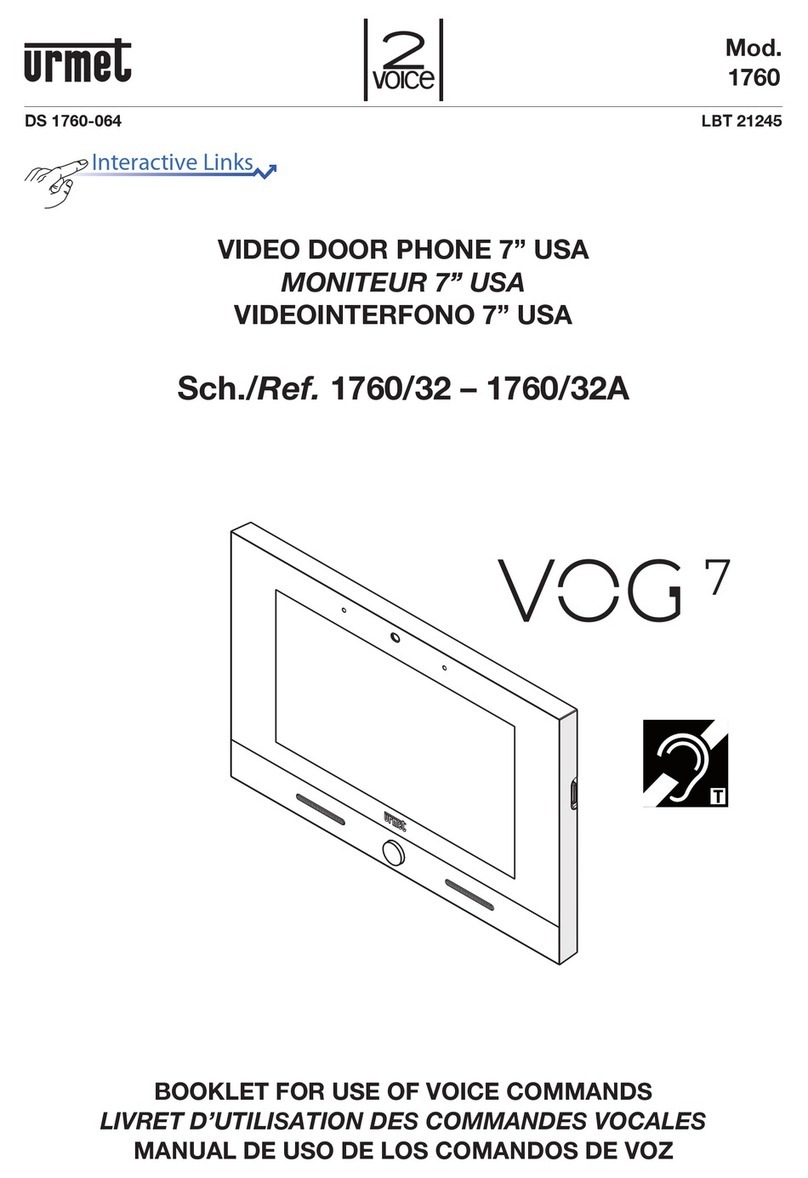
urmet domus
urmet domus VOG7 1760 Booklet
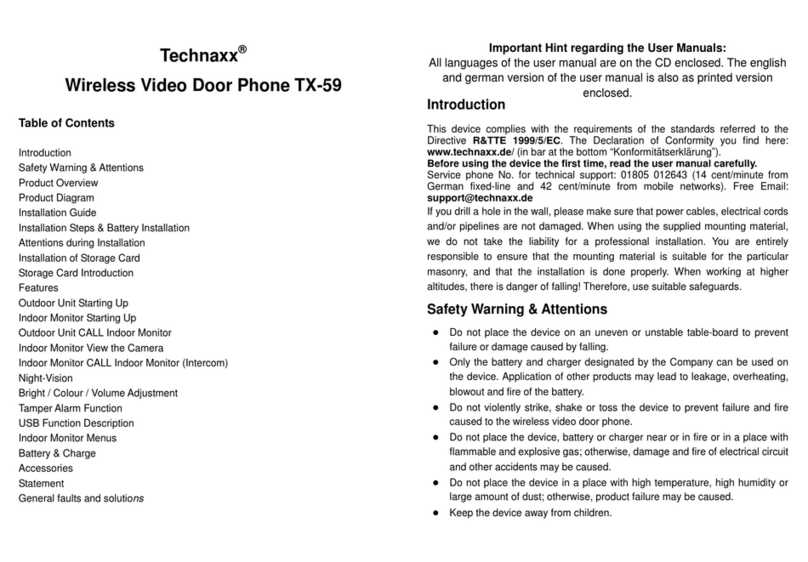
Technaxx
Technaxx TX-59 user manual
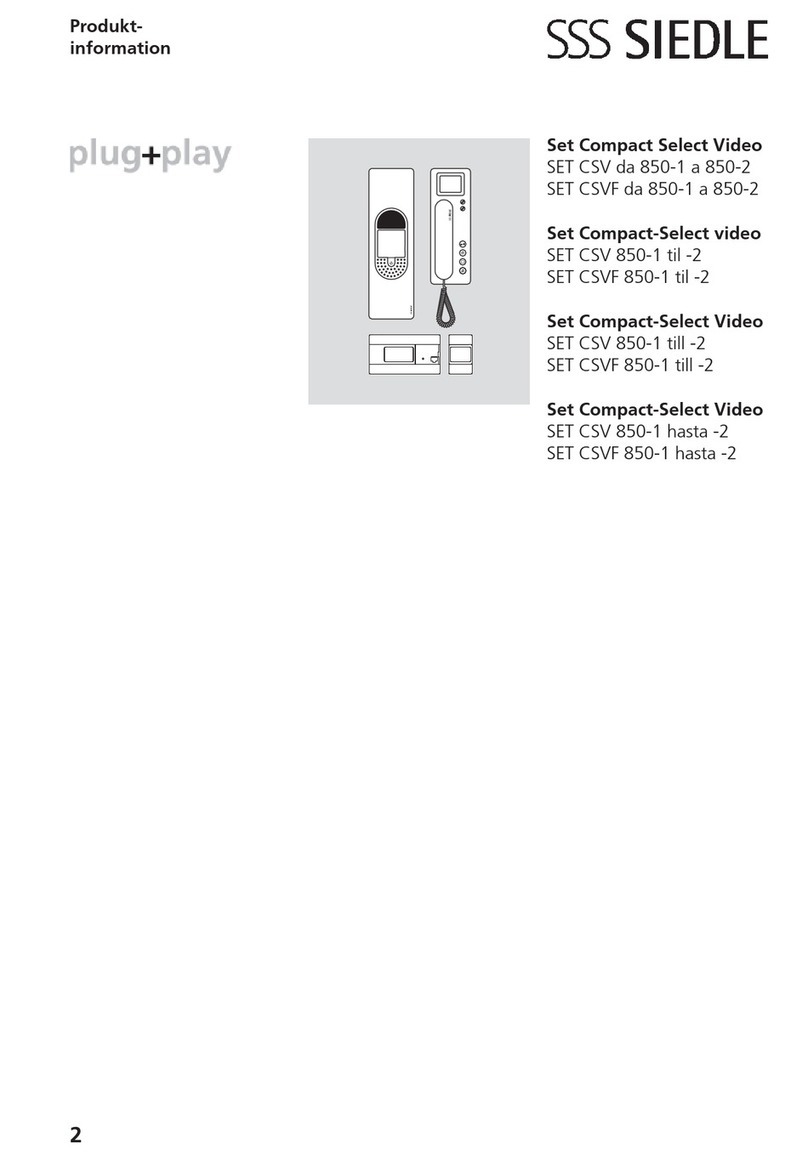
SSS Siedle
SSS Siedle Compact Select CSV 850 Series Product information

Smartwares
Smartwares DIC-22815 instructions
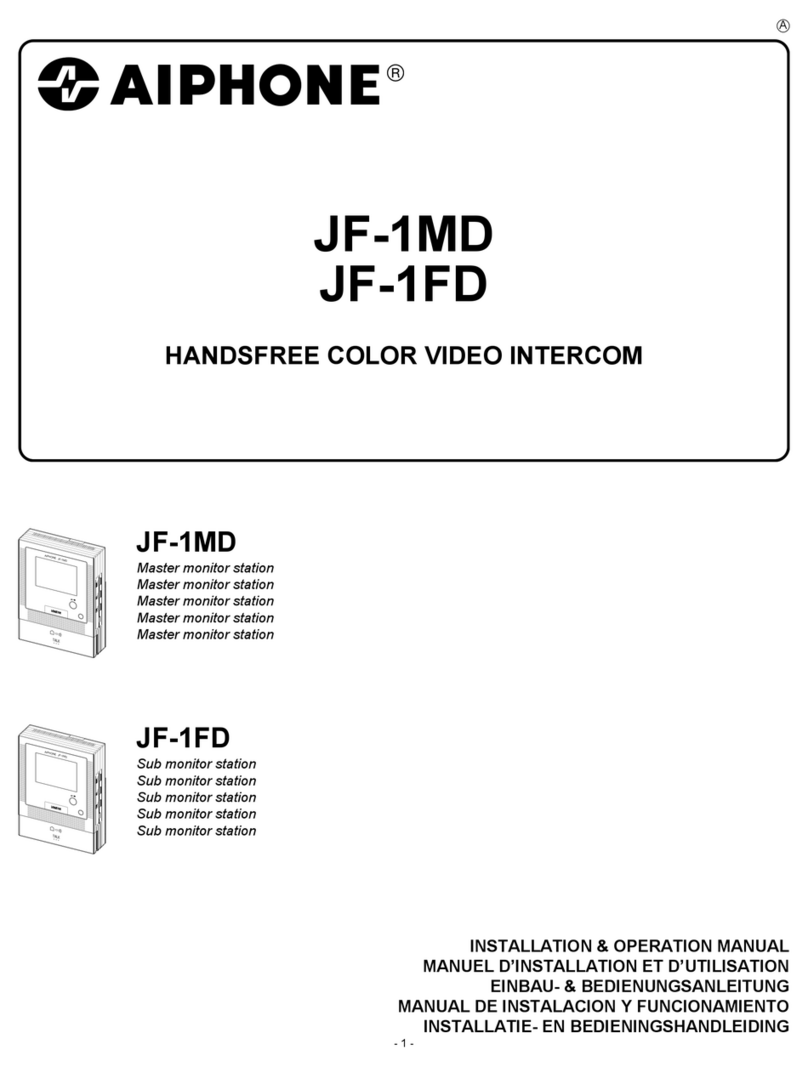
Aiphone
Aiphone JF-1MD Installation & operation manual
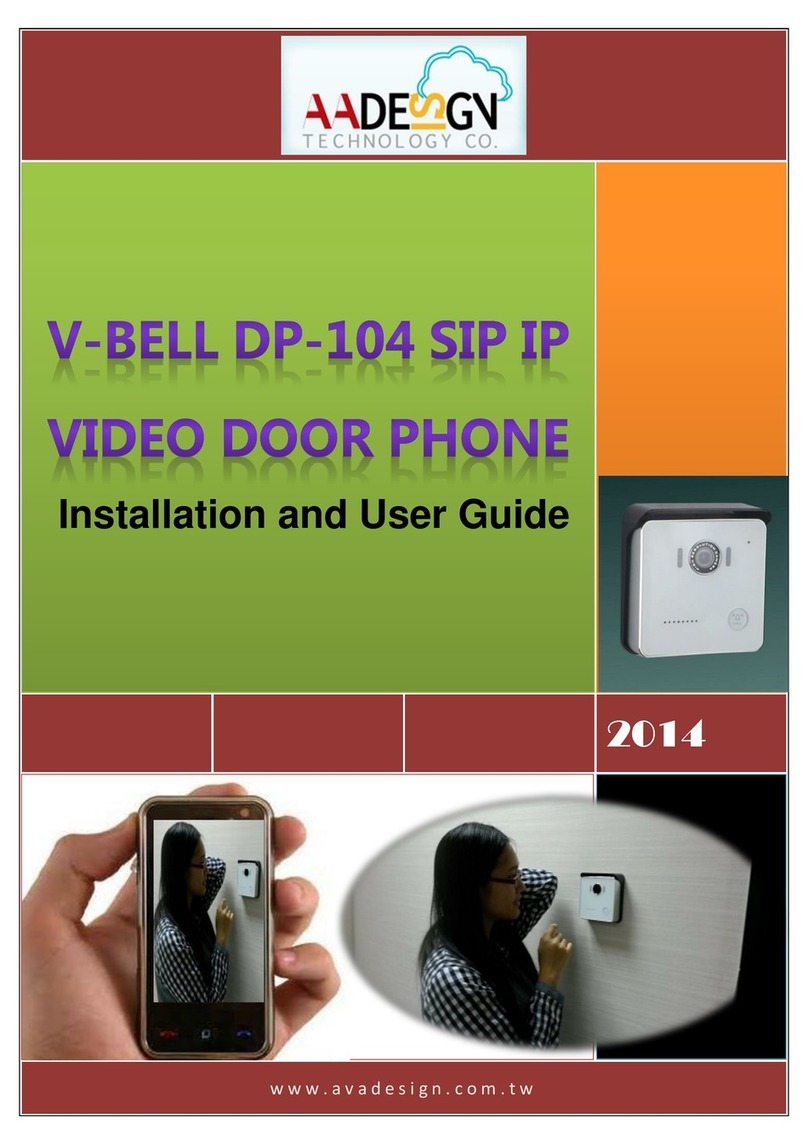
Avadesign
Avadesign V-Bell DP-104 SIP IP Installation and user guide
